Idemitsu Art Award 2023 Grand Prix Winner Interview
I want to create paintings with rhythm
Idemitsu Art Award 2023 Grand Prize Yuriko Takahashi
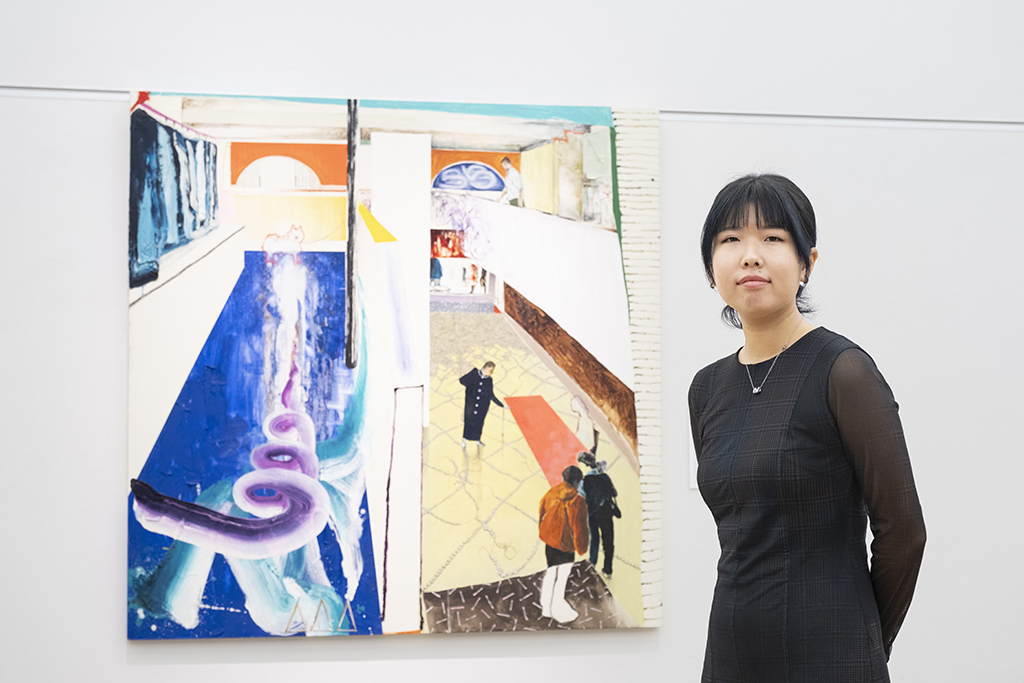
New talent was discovered this year as well. The Idemitsu Art Award is a public exhibition of two-dimensional works by artists under the age of 40, sponsored by Idemitsu Kosan. Inheriting the spirit of the Shell Art Prize, which has a proud history dating back to 1956, it will change its name in 2022 and focus more on supporting young artists.
At this year's 52nd Idemitsu Art Award 2023, Yuriko Takahashi's “Indoor Rhythm” was selected from among 831 entries by 617 artists. Mr. Takahashi was born in Hokkaido in 1998 and lives in Yamagata Prefecture. He is an up-and-coming artist currently enrolled in the first year of the master's program in the Art and Culture Department of Tohoku University of Art and Design. Ahead of the "Idemitsu Art Award Exhibition 2023," which will be held at the National Art Center, Tokyo from December 13th to introduce this year's award-winning and selected works, we spoke to Mr. Takahashi about the award-winning works and his future works.
Choose a work from regular productions and challenge it to a competition
─ Congratulations on winning the “Idemitsu Art Award 2023” Grand Prix. I heard that the decision was unanimous among the judges. Mr. Takahashi, please tell us why you applied for this award.
The reason for applying is that you can see the actual item and judge it, the application requirements are up to the size of S100 canvas (162.0 x 162.0 cm), and each person can submit up to 3 items. I myself like to create 100-size paintings, and from the works I have drawn, I have selected three pieces, M (162.0 x 97 cm), F (162.0 x 130.3 cm), and S (162.0 x 162.0 cm), and the color and color. I selected and applied for the ones that each had different merits, such as content. I thought it would be a comprehensive view, so I chose it to show the breadth of expression.
─ So you originally painted large works?
yes. I didn't draw it to enter a competition, but when I thought about submitting it to a competition, I thought I could submit it because the work I had already drawn met the requirements. Size 100 is easy to handle because the long side is about the same as your height, and size 200 starts to feel “big” to me.
─ All three of Mr. Takahashi's works made it to the second round of judging, and it seems that the Grand Prix work left the strongest impression. What I just said makes it clear that I took on the challenge of competing in the midst of constant production on a daily basis.
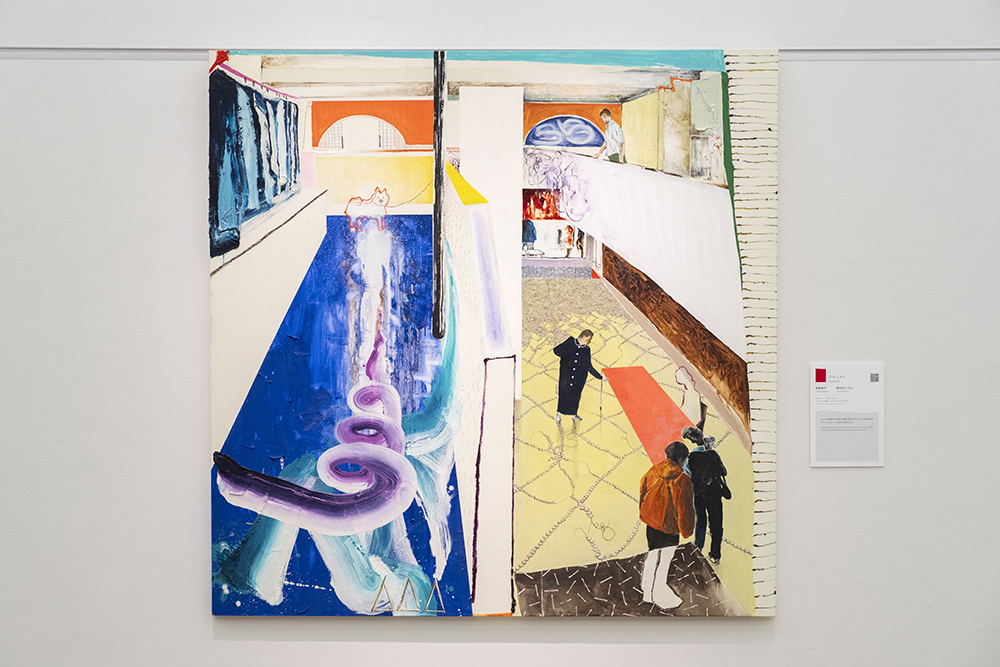
Yuriko Takahashi "Indoor Rhythm" 2023, 162 x 162 cm, acrylic, oil, pastel, canvas
Expressing rhythm with free speed and color and shape
─ How do you usually create your work? Also, please let us know if you have taken on any new challenges with your winning work.
I draw what I want to draw or what I think I can draw based on places I've been and things I've seen. However, for the architectural structure incorporated into this work, I used a photo of the Olivetti showroom in Venice, which I had never been to, as a reference. A friend of mine who is studying architecture took some wonderful photos when he went to Europe for training, and he lent them to me to use in his drawings. Since I haven't been there myself, I thought it would be wrong to draw it exactly as it is, so I drew it by combining images of bazaars that I saw at civic centers during my travels.
─ Do you draw things you have experienced for other reasons, such as to trace your own footsteps or memories?
No, I don't have any memories or messages to write about. I can't compose a painting from images alone, so I usually look at photographs I've taken myself to create a sense of reality. At that time, I only use parts that seem interesting as a picture and change them from the actual thing.
─ The composition uses building structures such as walls and pillars to divide the screen into two left and right. The motif is mysterious, but how did you choose it and how did you compose it? For example, on the right side, there are some people who are clearly drawn and others who are almost just outlines. Also, countless particles are drawn on the floor.
As the title “Indoor Rhythm” suggests, the theme is rhythm, so if you can clearly see the difference in people's drawings and the slowness and speed, I think this painting is a success. I remembered that there were accessories made from beads among the items at the bazaar, and it wouldn't be interesting to draw them as they were, so I incorporated them into the floor.
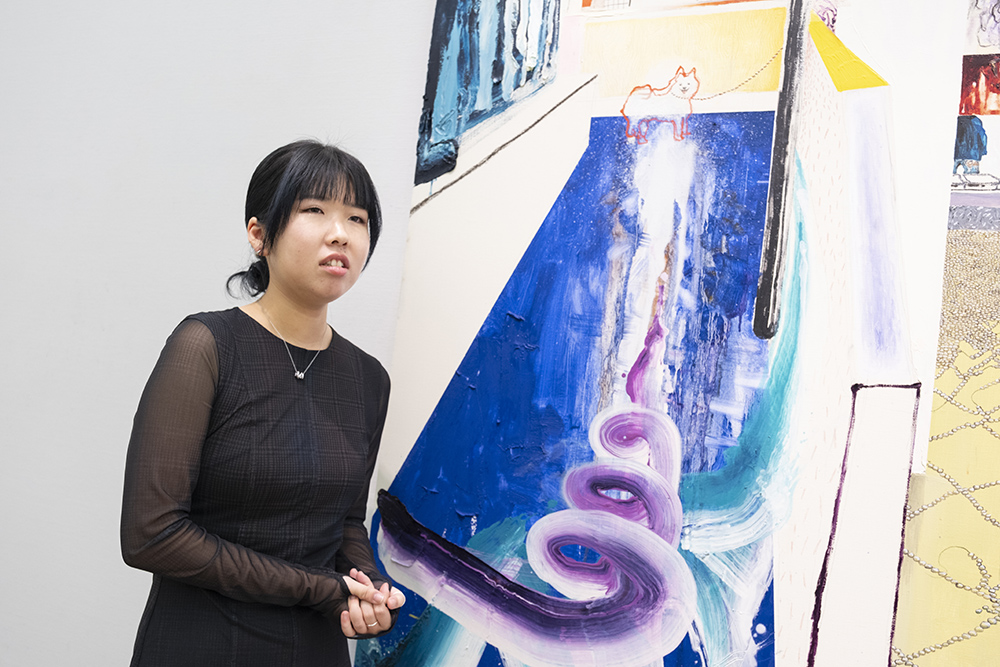
─ On the left side of the painting, the dog with a blurred outline catches your eye. Below that, a spiral is drawn with vigorous strokes.
I have also used small animals in other works as well. I decided to draw a video I saw on Instagram or YouTube that day, and that day I saw a video of a Samoyed. There is a man holding a koala in the lower right corner, and I saw a video of a koala that day (lol). There's no reason, it's just timing. The left side is weak, so I thought the picture wouldn't hold up unless there was an interesting shape, so I drew a dog on top, and this time, the bottom was weak, so I added a spiral. It was created by adding to the drawings like that.
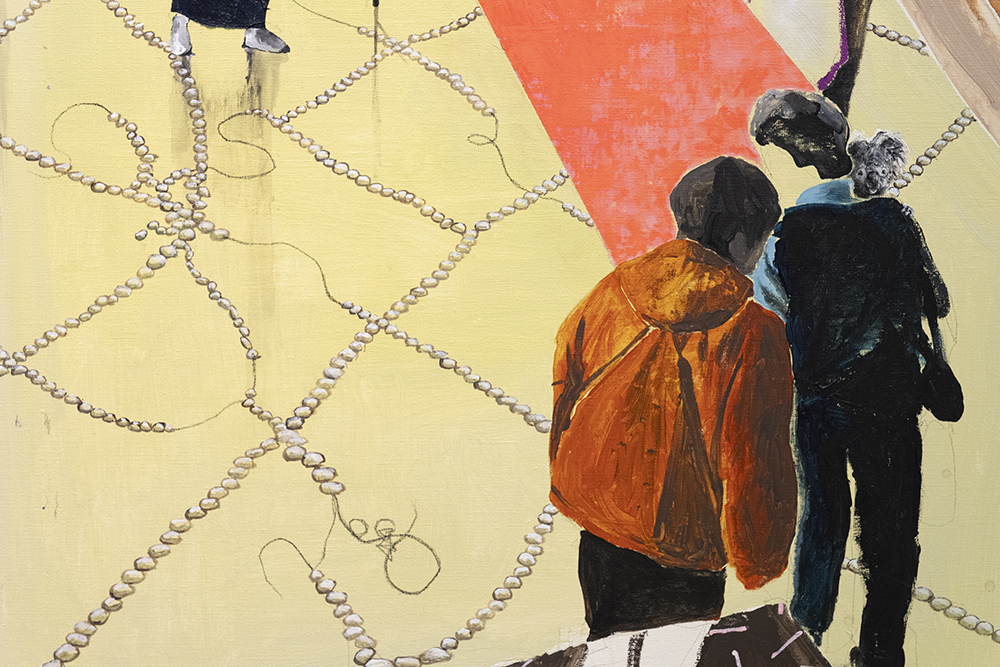
Bottom right of the work, partial photo of beads and people drawn on the floor
─ Do you mean drawing each one one by one and adding and subtracting them while interacting with the screen?
I draw a rough sketch first, but once it's completed to a certain extent and I put it on the canvas, I end up just carrying out the sketch, so I think it's best to not make too many decisions and just watch the progress as I complete it. I'm thinking about it and doing it.
─ So, how do you apply the colors?
First, decide on just one color and paint the wide area that looks the strongest, then match the colors from adjacent areas using your own rules. For this work, I first painted the left half of the floor blue, then painted the area near it yellow.
─ You also change the way you apply it. The upper left corner of the curtain is covered with a thick layer of paint, and the area below it is left unpainted, leaving only the lines drawn. Don't you mean that you want drawing (paintings that mainly involve lines) and paintings (paintings that mainly involve applying paint) to coexist on one screen?
I receive similar feedback from teachers at my school, but I don't feel that way myself.
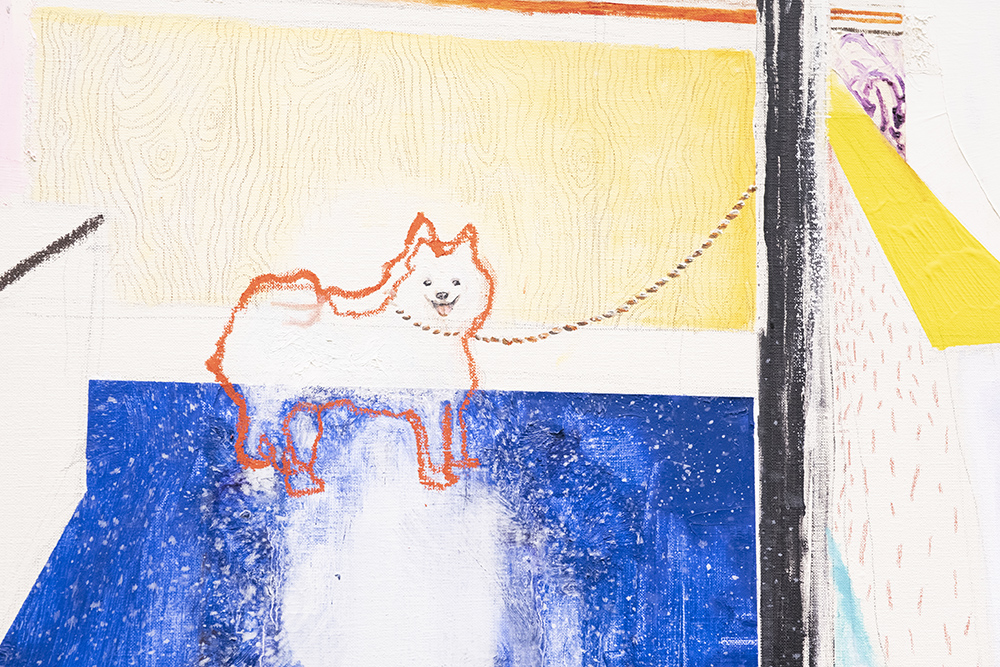
Top left of the piece, Samoyed chained
─ The rhythm seems to be created not by constant repetition, but by gaps and gaps, and I never get tired of looking at it. Do you have a desire to create paintings that are both figurative and abstract at the same time?
I value the balance between concrete and abstract. I want to be able to have the best aspects of both coexist in my paintings, without relying too much on one side or the other.
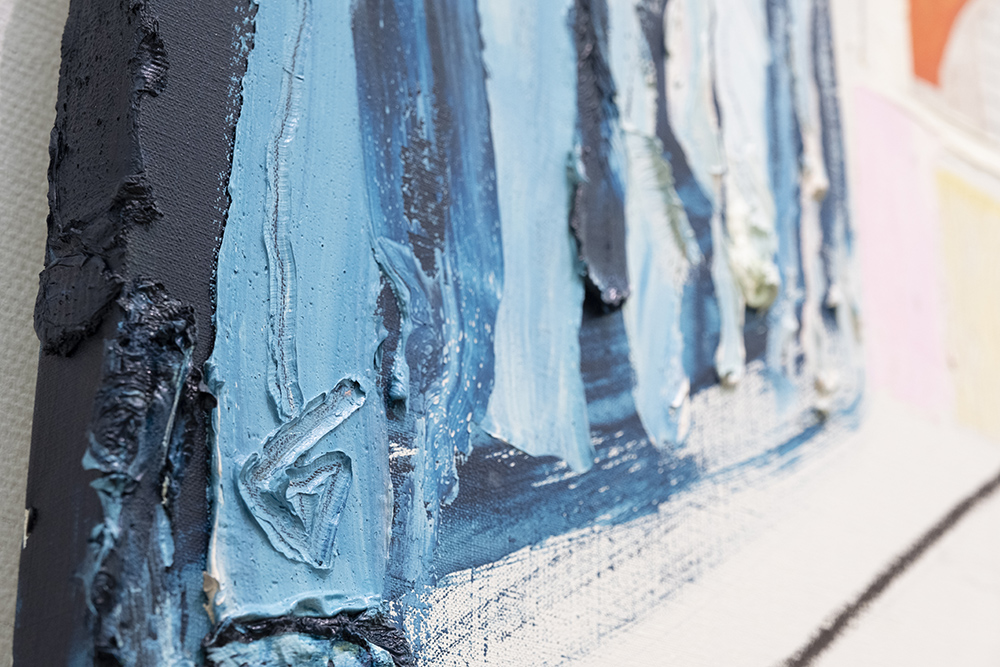
Top left of the work, thickly painted curtain and canvas underneath
There is a competition for people who want to continue creating.
─ Now, let's go back and ask about your past activities. When did you start drawing?
It started when I was in my third year of high school, when I went to an art preparatory school in order to enter an art university. My parents told me to work after graduating from high school, but I wanted to go to university. I thought that if I were to go to an art school, I would have to learn skills rather than studying to get into it. While I had many options, including the School of Design, I thought oil painting was the most art school-like option, but it was difficult at first because oil paints were difficult to use. But I didn't want people to think I gave up right away, so I guess I got used to it as I worked really hard.
─ Why did you choose Tohoku University of Art and Design?
The main reason I chose Tohoku University of Art and Design was that the tuition fees were reasonable. Since the number of students is small, I feel that the teachers are paying close attention to all students. I think each student is given ample space to create their own work, and many professors teach students with the idea that since they came to art school, they should gain experience in creating large-scale works.
─ Does this mean that you should take on challenges without fear of failure?
yes. I think there is an environment where you can work freely until the end.
─ Do you present your work outside of the university?
I have participated in a group exhibition at an art gallery that my professor invited me to participate in, but I have not taken the initiative to exhibit outside of the university. Right now, I think it would be better to accumulate my works rather than actively presenting them.
─ The “Idemitsu Art Award 2023” exhibition will begin on December 13th. Are there any particular viewing points that you would like visitors to see?
Please feel free to take a look. Painting is lonely because I have to create it alone, but I am happy that I have had the opportunity to introduce myself to so many people through the works I create.
─ How would you like to continue your activities?
I've never had a solo exhibition, so I'd like to do it in a good place. Also, since I have never left Japan, I would like to apply if there is an opportunity for overseas training. I would like to go to France or England.
─ Please give a message to those who will apply for the “Idemitsu Art Award” from now on.
Two-dimensional works have a quality that cannot be appreciated until you see them in person, and I think the appeal of the “Idemitsu Art Award” lies in the fact that the actual works are judged. I myself didn't expect to receive an award, but you won't know until you submit it, so I'd like to submit it first, and if I receive feedback, it will encourage me to continue producing.
─ In your case, it might actually be a good thing that you weren't thinking about awards. What does the competition mean to you, Takahashi?
I think it's something that comes from people who want to continue producing. Even if you make good work, you won't be able to continue if no one sees it, so I think it's important to release something as a great opportunity for people to see it and as a way to pave your own path. Now that I'm in graduate school, I have a place secured and people are looking at me, but after I graduate, I have to work hard on my own. I think it has great meaning for such students as well.
─“To continue producing” is a very honest phrase. Do you ever want to be a writer like this, or do you want to try something like this because of the prize money?
I want to continue without straining myself, so I would like to use the prize money to continue producing after I graduate.
─ Information tends to be centered around Tokyo, but I think the Idemitsu “Art Award” is an opportunity to shine a light on artists who continue to create with roots in the region. I look forward to seeing Mr. Takahashi's future endeavors.
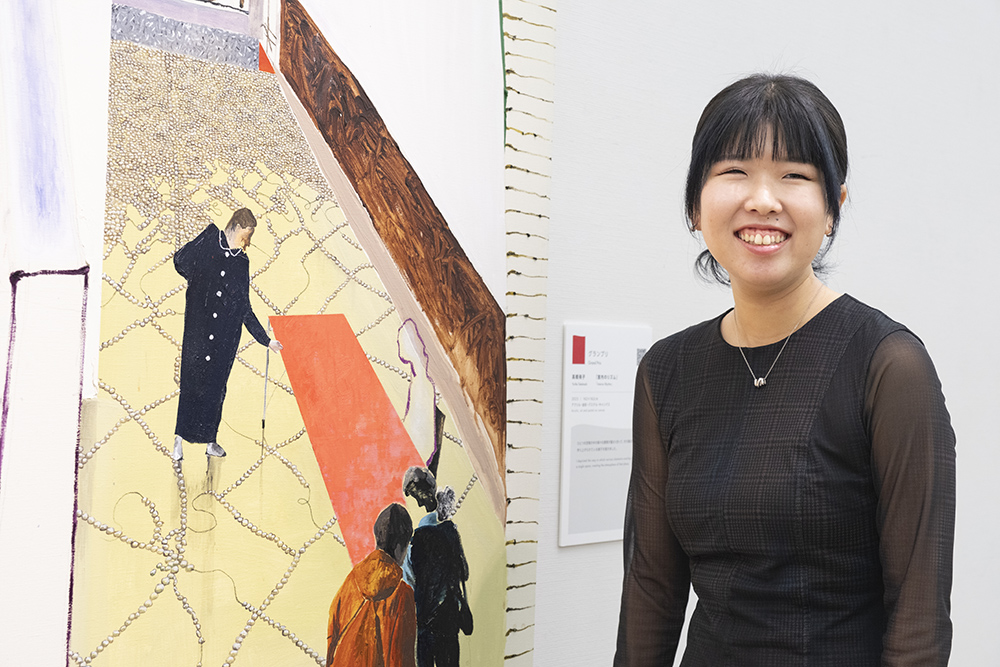
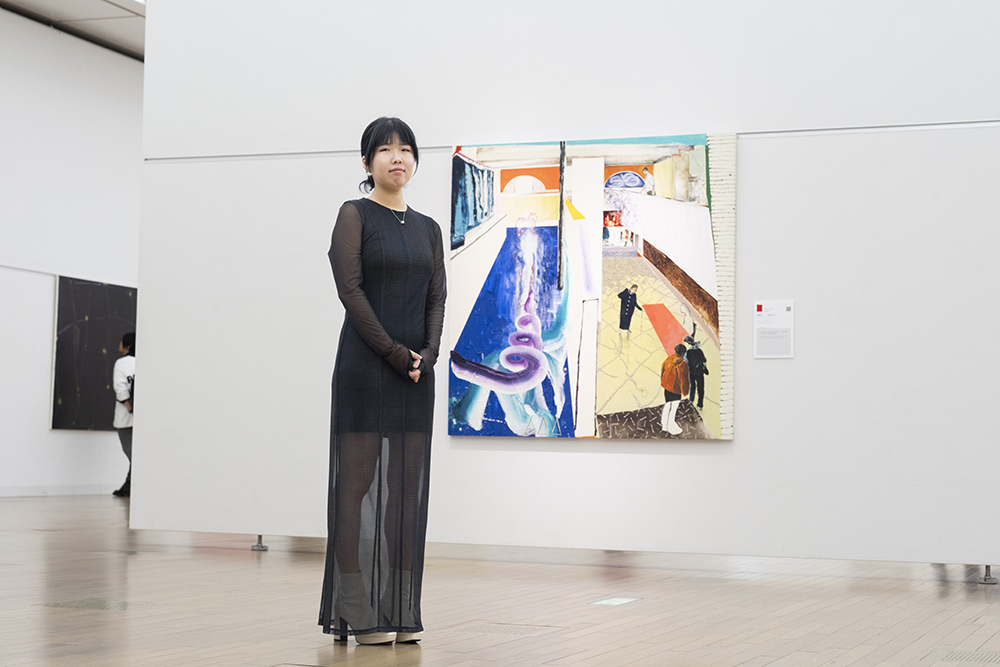
Originally published on the contest information site "Toryumon" Text by Yuri Shirasaka
Photo: Seiji Ishigaki Edited by: Attori Hagiwara (JDN)